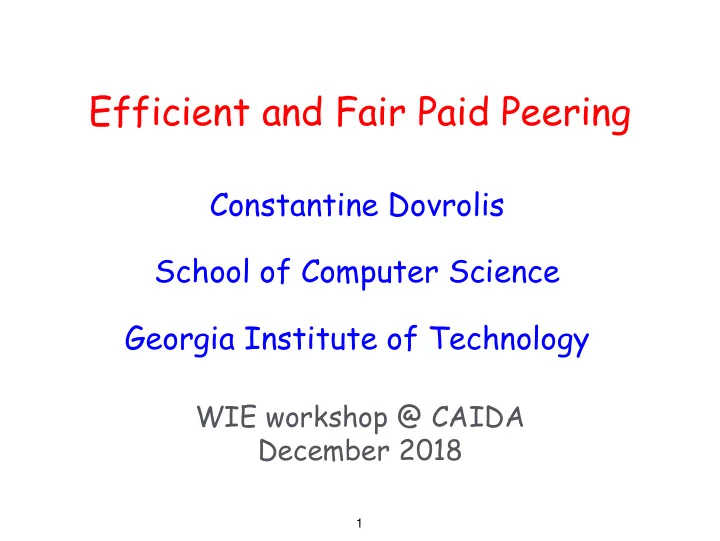

Efficient and Fair Paid Peering Constantine Dovrolis School of Computer Science Georgia Institute of Technology WIE workshop @ CAIDA December 2018 1
Collaborators & funding sources • Michael Schapira, Hebrew Univ. of Jerusalem • Doron Zarchy, Hebrew Univ. of Jerusalem • Amogh Dhamdhere, CAIDA • Mikhail Klimenko, Economics, Georgia Tech
What goal/fear you try to address? The disputes between ISPs and CPs about interconnection cause serious performance problems. Misleading the public (and policy makers) to think that some of form of regulation is necessary. While in reality, a more rational form of setting up peering interconnections would suffice. We propose an efficient and fair paid-peering interconnection model that we call Nash-Peering. 3
A and B: direct or indirect interconnection? C A =$10 A B C B =$2 C’ A =$12 C’ B =$8 O A O B Outside options for A & B (e.g., transit providers or CDNs)
Nash solution (1951) • Nash Solution • If surplus>0, A and B should split surplus equally • Otherwise, stay with outside option • John Nash proposed this based on a set of “axioms”: • Pareto efficiency (there is no better solution for both parties) • Symmetry • Invariance to affine transformations • Independence of irrelevant alternatives
x 1 +x 2 =w Slide by Milan Vojnovic, Microsoft Research
Dynamic bargaining process • Two players negotiate iteratively taking turns • Probability of “negotiation breakdown”: close to 0 • Under reasonable assumptions, the process will converge to unique perfect equilibrium, which is the Nash Solution Binmore, Rubinstein, Wolinsky (1986), “The Nash Bargaining Solution in Economic Modeling”
Nash-Peering Simply apply Nash solution to bilateral bargaining • between two ASes A and B: • Costs of direct interconnection: c A , c B • Costs of indirect interconnection (outside option): c ’ A , c ’ B • Interconnection takes place iff (c ’ A -c A ) + (c ’ B -c B )>0 • A pays to B: [(c ’ A -c A ) - (c ’ B -c B )] /2 if > 0 • Otherwise B pays to A -[(c ’ A -c A ) - (c ’ B -c B )] /2
Nash-peering example C A =10 $ A B C B =2 C’ B =6 C’ A =20 O A O B 1. Interconnection is established as (20-10)+(6-2)=14 > 0 2. A pays to B : 1/2*[(20-10)-(6-2)]= 3
Nash-peering example C A =10 $ A B C B =2 C’ B =6 C’ A =8 O A O B 1. Interconnection is established as (8-10)+(6-2)=2 > 0 2. A pays B: 1/2*[(8-10)-(6-2)]=-3 ➡ B pays to A $ 3
Nash-peering example \ C A =10 A B C B =2 C’ B =6 C’ A =3 O A O B Interconnection is not established as (3-10)+(6-2)=-3 < 0
What data do we need to further understand Nash-Peering? (and maybe convince others for its utility) Traffic flow data and cost-related data: Ideally at different performance levels -- and with interconnections of different capacity But.. it is highly unlikely that we will ever get this data from ISPs or CPs (we tried and failed..) However, there are non-profit network providers (e.g., research/academic networks) and non-profit content providers that may be more willing to share data CAIDA can play a key role in identifying such parties and collecting the data
Some additional references 1. D.Zarchy, A. Dhamdhere, M. Schapira and C.Dovrolis, Nash-Peering, A new techno-economic framework for Internet interconnections, Global Internet Symposium, 2018. 2. A. Lodhi, A. Dhamdhere, N.Laoutaris, and C. Dovrolis, Complexities in Internet Peering, In Proceedings of the IEEE INFOCOM, 2015. 3. A. Lodhi, L. Natalie, D. Amogh, C. Dovrolis, and K. Claffy, Using PeeringDB to Understand the Peering Ecosystem, SIGCOMM Computer Communications Review, 2014. 4. A. Lodhi, A. Dhamdhere, and C. Dovrolis, Open Peering by Internet Transit Providers: Peer Preference or Peer Pressure?, In Proceedings of the IEEE INFOCOM, 2014.
Recommend
More recommend